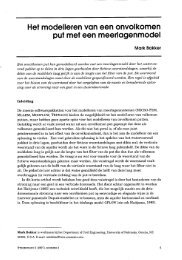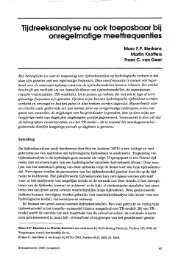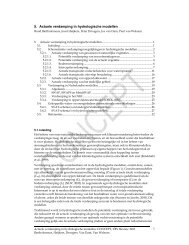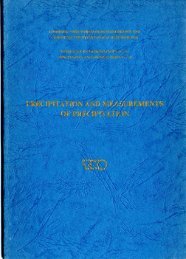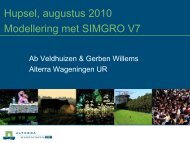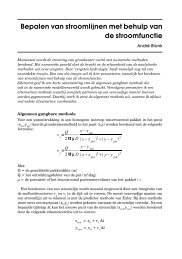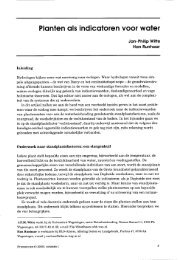Hydro-ecological relations in the Delta Waters
Hydro-ecological relations in the Delta Waters
Hydro-ecological relations in the Delta Waters
You also want an ePaper? Increase the reach of your titles
YUMPU automatically turns print PDFs into web optimized ePapers that Google loves.
Of course. tke environmental changes have not only <strong>in</strong>fluenced <strong>the</strong><br />
vegetatian but also <strong>the</strong> fauna. Figure 5 gives an idea of <strong>the</strong> dynamics<br />
of <strong>the</strong> breed<strong>in</strong>g bird populations on pne of <strong>the</strong> newly emergod islands <strong>in</strong><br />
Lake Grevel<strong>in</strong>gen. &er <strong>the</strong> constmction of <strong>the</strong> dam <strong>in</strong> <strong>the</strong><br />
Broursershaveuse Gat some 400 hectares of tidal flats and a wll salt<br />
marsh were exposed to <strong>the</strong> air and w<strong>in</strong>d. &specially <strong>the</strong> species of sandy<br />
beaches and pebble coasts (We <strong>the</strong> Kentish Plover) began to breed on<br />
<strong>the</strong> new land. The population of Bedshank, also a coastal bird, did not<br />
<strong>in</strong>crease before some vegetation was exist<strong>in</strong>g. airily because <strong>the</strong> h-<br />
needed this vegetation to hide <strong>the</strong>ir nests. At that time <strong>the</strong> species of<br />
bare beaches were alrea* deel<strong>in</strong>hlg. The fimt breed<strong>in</strong>g birds of shrlibs<br />
have colonized <strong>the</strong> island only recently and a common species like <strong>the</strong><br />
Villow Warbler is still <strong>in</strong>creas<strong>in</strong>g. Woodland species do not breed on<br />
<strong>the</strong> island, because vegetation structure has not yet been<br />
dfiferentiated enough and <strong>the</strong>re are no nestiag sites for <strong>the</strong>se birds.<br />
It will take at least some 50-1Wl years before <strong>the</strong> bird communities<br />
beg<strong>in</strong> to stabilfae.<br />
G-rally<br />
speak<strong>in</strong>g <strong>the</strong> foll4ng factors <strong>in</strong>fluence <strong>the</strong> developnent of<br />
vegetation and animal wildlLfe an <strong>the</strong> former dt marshes and tidal<br />
f late :<br />
* <strong>the</strong> <strong>in</strong>itial ecosystem present at <strong>the</strong> moment of dw constrnctiod;<br />
* processes of adaption ta <strong>the</strong> newly created situation;<br />
* mahagement of water and Land by m=.<br />
3.1 Initial ecosystems<br />
The newly developed ecosystems have <strong>the</strong>ir start<strong>in</strong>g po<strong>in</strong>t <strong>in</strong> <strong>the</strong> old<br />
estuadne waters. These Mtial ecosystems are strongly <strong>in</strong>flucn-d by<br />
<strong>the</strong> orig<strong>in</strong>s1 waterrepime. This Fs illustrated by <strong>the</strong> distribution of<br />
<strong>the</strong> vegetation series qf Figure l <strong>in</strong> relation to height and tidal<br />
floo6<strong>in</strong>g (see Fig. 6). p e vegetation types <strong>in</strong>asated hy an open<br />
rectangle died with<strong>in</strong> rwo or three years &ter embanlaaent was f<strong>in</strong>ished





